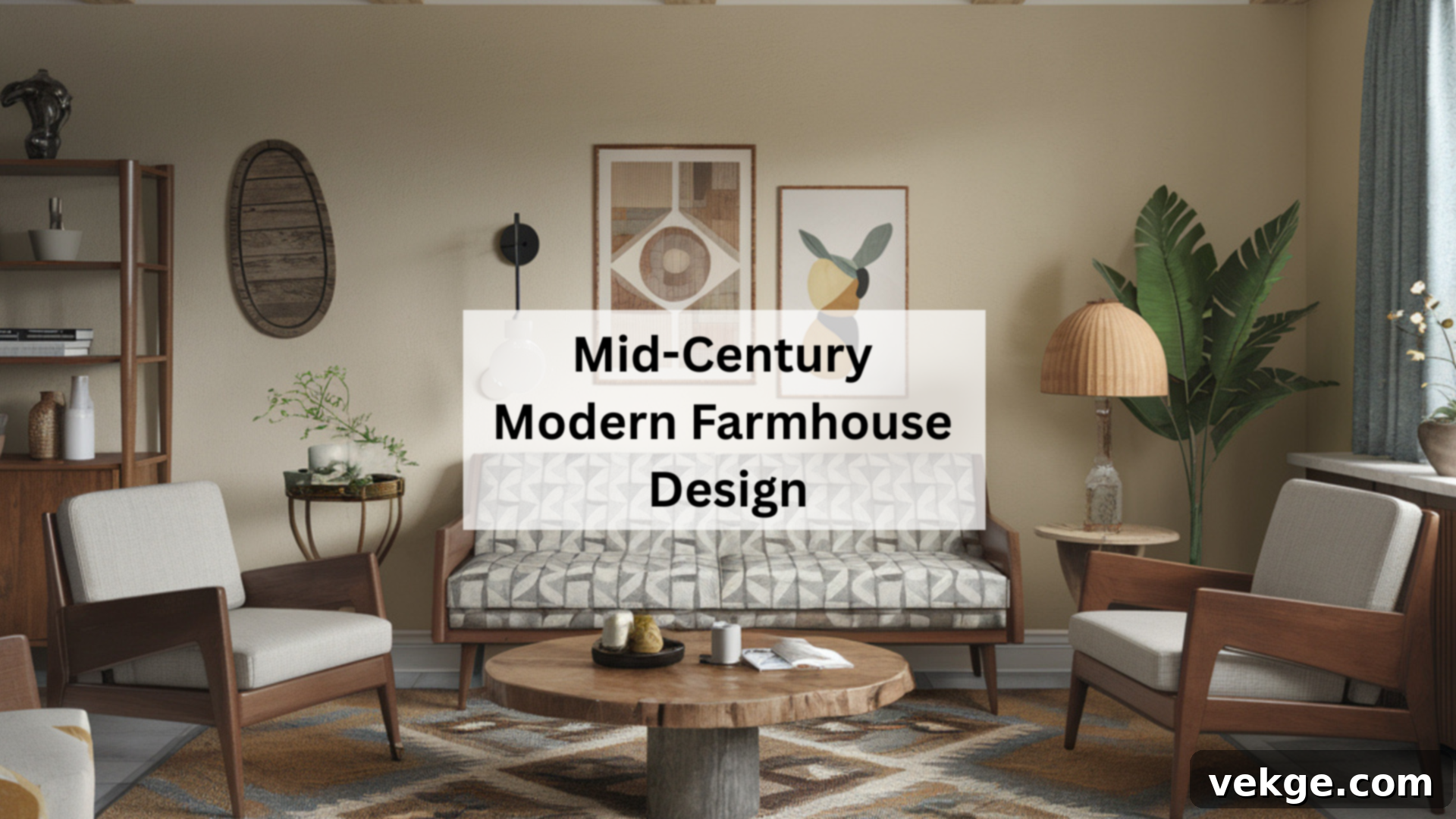Mastering Mid-Century Modern Farmhouse: Blending Timeless Style and Cozy Comfort
Imagine a space where the clean lines and sophisticated simplicity of mid-century modern design meet the rustic warmth and inviting charm of a farmhouse. This unique fusion creates an interior that is both fresh and welcoming, a testament to thoughtful design that doesn’t sacrifice comfort for style.
The Mid-Century Modern Farmhouse style is rapidly gaining popularity among homeowners and designers who appreciate an aesthetic that feels curated, lived-in, yet undeniably chic. It’s about finding that perfect equilibrium between sleek functionality and organic coziness, resulting in environments that are both visually appealing and highly livable. This blend allows for versatile decorating, embracing smooth shapes, natural textures, and a harmonious color palette that speaks to both eras.
This mix is ideal for anyone who enjoys the calm, uncluttered look of modern design but still desires a space that feels relaxed, authentic, and connected to tradition. With the right combination of rich woods, elegant metals, soft textiles, and a gentle, earth-inspired color scheme, you can shape a home that is effortlessly functional and feels just right for everyday living.
In this comprehensive guide, we will delve into practical strategies for seamlessly combining these two distinct design philosophies without compromising on comfort, character, or the unique essence of each style. Discover how to create a home that truly reflects your personal taste, blending the best of both worlds into a cohesive and inspiring aesthetic.
Understanding the Core: Mid-Century Modern vs. Farmhouse Style
To successfully blend mid-century modern and farmhouse aesthetics, it’s essential to first grasp the defining characteristics of each individual style. This foundational understanding will empower you to make informed design choices that honor both traditions.
Characteristics of Mid-Century Modern Style
Originating from the post-World War II era (roughly the 1940s to the 1960s), mid-century modern design emerged as a response to the optimism and innovation of the time. It champions a philosophy of simplicity, functionality, and organic forms.
- Clean Lines and Geometric Shapes: Furniture and architectural elements feature streamlined silhouettes, often with tapered legs, rounded corners, and a lack of excessive ornamentation.
- Minimalism and Functionality: Every piece serves a purpose, and clutter is avoided. Design focuses on efficient use of space and practical solutions.
- Innovative Materials: While wood (teak, walnut, oak) is prominent, mid-century modern also embraced new materials like molded plywood, fiberglass, plastic, and sleek metals.
- Connection to Nature: Large windows, open floor plans, and a seamless flow between indoor and outdoor spaces are common, bringing natural light and views inside.
- Iconic Furniture: Think Eames chairs, Saarinen tables, and Noguchi coffee tables – pieces that are still celebrated for their timeless appeal and ergonomic design.
- Bold but Balanced Colors: A neutral base is often punctuated with vibrant accent colors like avocado green, mustard yellow, burnt orange, or teal.
Characteristics of Farmhouse Style
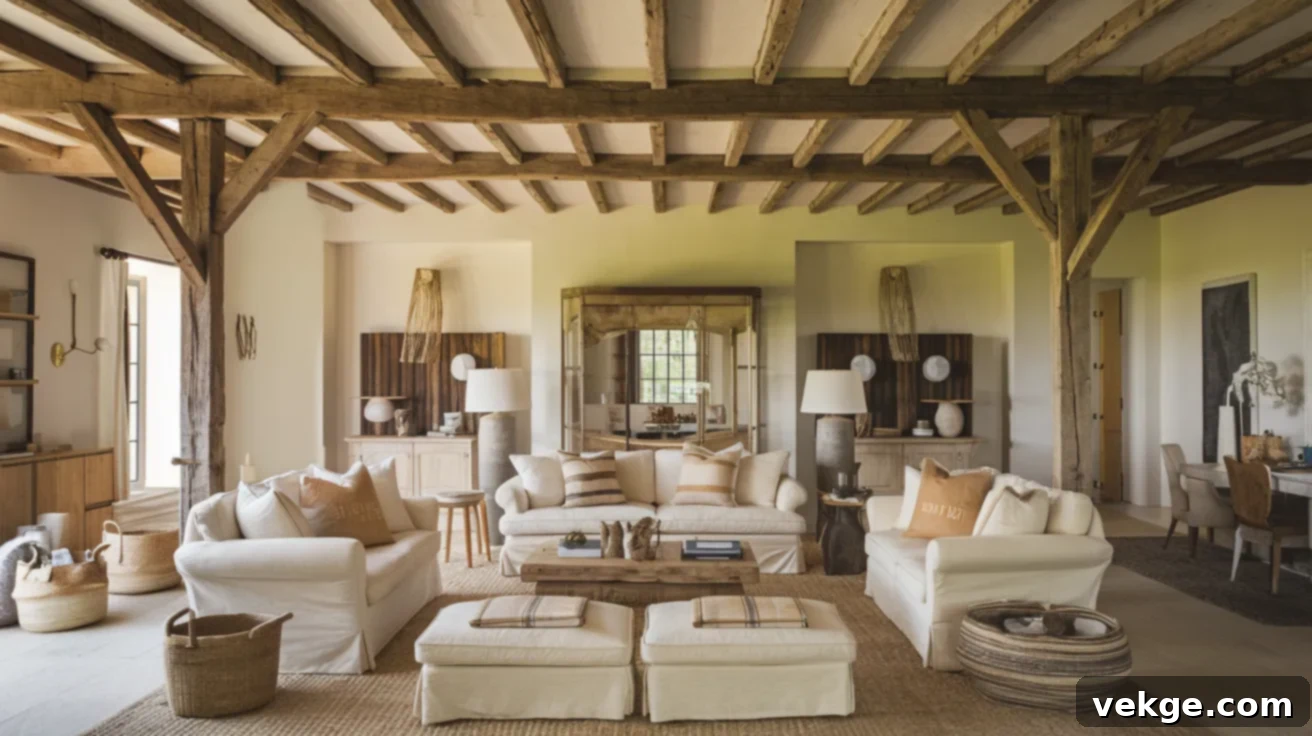
Farmhouse style evokes a sense of nostalgia, warmth, and authenticity, drawing inspiration from rural living. It prioritizes comfort, practicality, and a connection to nature and history.
- Natural Materials and Textures: Abundant use of reclaimed wood, exposed beams, natural stone, wrought iron, cotton, linen, and jute.
- Neutral Color Palettes: Whites, creams, grays, and soft earth tones form the foundation, often complemented by muted blues, greens, and browns.
- Comfortable and Practical Furnishings: Overstuffed sofas, sturdy wooden tables, and functional seating arrangements designed for everyday use.
- Vintage and Rustic Accessories: Antiques, galvanized metal accents, cast iron pieces, ceramic dishware, and woven baskets add character.
- Emphasis on Craftsmanship: Hand-hewn elements, visible joinery, and a celebration of traditional techniques are often incorporated.
- Welcoming and Lived-in Feel: Spaces are designed to feel inviting, unpretentious, and ideal for gathering, often featuring large, communal tables and cozy nooks.
- Distinctive Elements: Oversized apron sinks, barn doors, shiplap walls, and open shelving are common hallmarks.
Blending Mid-Century and Modern Farmhouse Designs: A Harmonious Approach

Successfully combining mid-century modern and farmhouse styles is an art that requires a thoughtful approach, recognizing and respecting the unique qualities of both design philosophies. This creative blending allows homeowners to craft spaces that feel simultaneously contemporary, timeless, and deeply comfortable.
Creating Balance Between the Two Styles
The key to merging these distinct styles lies in creating a harmonious balance where neither dominates the other. Focus on selecting pieces that complement each other’s strengths rather than clashing. It’s about a conversation between the sleek and the rustic, the sophisticated and the unpretentious.
- Embrace Clean Lines with Natural Textures: Choose mid-century modern furniture pieces that feature simple geometric shapes, tapered legs, or streamlined silhouettes. Soften these clean lines by pairing them with warm, natural textures characteristic of farmhouse style, such as reclaimed wood, woven textiles, and organic fibers.
- Strategic Color Palette: Start with a neutral foundation of whites, soft grays, and warm beiges to provide a versatile backdrop. Introduce accent colors sparingly, drawing from both palettes – perhaps a mid-century mustard yellow cushion on a rustic wooden bench, or a farmhouse-inspired muted blue throw over a modern sofa.
- Mix Materials Thoughtfully: Combine the industrial appeal of mid-century metals (brass, chrome, steel) with the earthy charm of farmhouse wood and wrought iron. For instance, a dining table could feature a sleek metal base with a raw, wooden tabletop.
- Layering Old and New: Integrate vintage farmhouse finds, like antique crocks or galvanized buckets, with modern abstract art or minimalist sculpture. This juxtaposition creates visual interest and tells a story.
- Prioritize Functionality: Both styles value practicality. Choose furniture and decor that are not only aesthetically pleasing but also serve a useful purpose, ensuring your space remains comfortable and efficient.
Key Features to Focus On for a Unified Look
When blending these design styles, prioritize specific elements that can effectively bridge the gap and create a cohesive, harmonious look throughout your home.
- Lighting Fixtures: Opt for mid-century modern lighting with metallic finishes, Sputnik designs, or geometric shapes to add a contemporary touch and sculptural element. Balance this with farmhouse-inspired fixtures like black metal lanterns, industrial-style pendants, or natural fiber shades that offer warmth and diffused light.
- Flooring: Embrace farmhouse-inspired wooden flooring, whether it’s wide-plank, distressed, or reclaimed wood, to lay a warm foundation. Complement this with mid-century geometric pattern rugs or natural fiber area rugs (jute, sisal) that add texture and define spaces.
- Furniture Selection: Look for furniture that embodies both styles. A sofa with clean lines and tapered legs can be upholstered in a natural linen or wool fabric. Pair sleek, minimalist chairs with rustic wooden tables. Ensure that furniture pieces have comfortable, inviting materials while maintaining their structural elegance.
- Metal and Wood Integration: Consciously mix metal and wood elements in your decor. A mid-century credenza made of walnut could sit beneath a gallery wall featuring rustic wooden frames mixed with minimalist metal ones. Use wrought iron hardware on cabinets alongside stainless steel appliances.
- Proportion and Scale: Pay close attention to the size and placement of your pieces. Ensure that neither style overwhelms the other. A large, rustic farmhouse table might be balanced by a set of delicate, mid-century modern dining chairs. Maintaining a cohesive color scheme will further allow both design approaches to shine without clashing.
- Textiles and Soft Furnishings: Introduce cozy throws, decorative pillows, and curtains in natural fabrics like cotton, linen, and wool. Choose patterns that lean towards either abstract mid-century designs or subtle farmhouse checks and stripes.
Room-by-Room Design Tips for a Blended Aesthetic
Applying the mid-century modern farmhouse style across different spaces requires careful consideration and creative thinking. Each room presents a unique opportunity to blend the clean lines of mid-century design with the warm, inviting elements of farmhouse styles.
Living Room
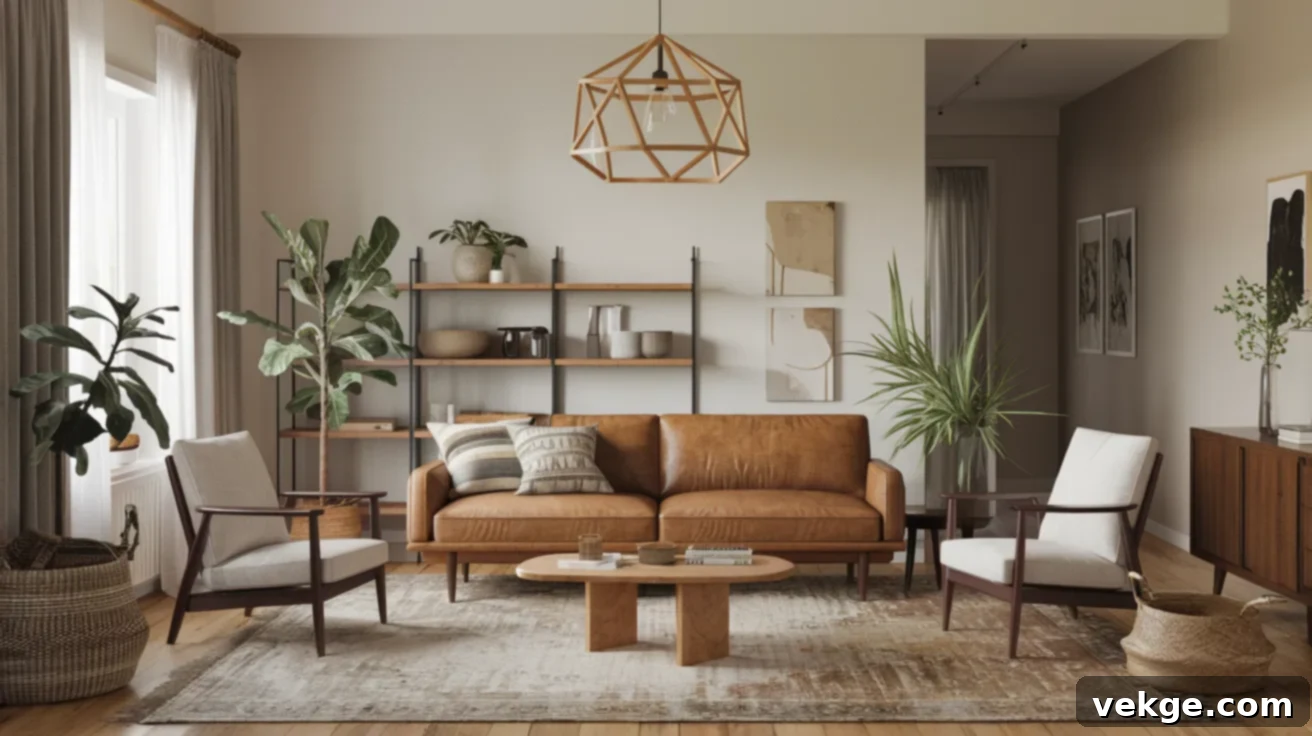
Transform your living room by balancing iconic mid-century modern furniture with comforting farmhouse-inspired accents. Select a sleek, low-profile sofa with tapered wooden legs, perhaps upholstered in a performance fabric or a rich leather. Soften the space with a chunky knit throw, a vintage wool rug featuring a subtle pattern, or natural linen curtains.
Install minimalist shelving units, such as a floating credenza or a simple wall-mounted system, alongside rustic wooden side tables or a reclaimed wood coffee table. Choose lighting fixtures that beautifully combine metal and wood elements—perhaps a geometric pendant light with a wooden base, or an arc floor lamp with a linen shade. Incorporate natural textures through woven baskets for storage, ceramic vases holding dried botanicals, and textured cushions that complement the clean lines of mid-century furniture, creating a cozy yet sophisticated gathering space.
Kitchen
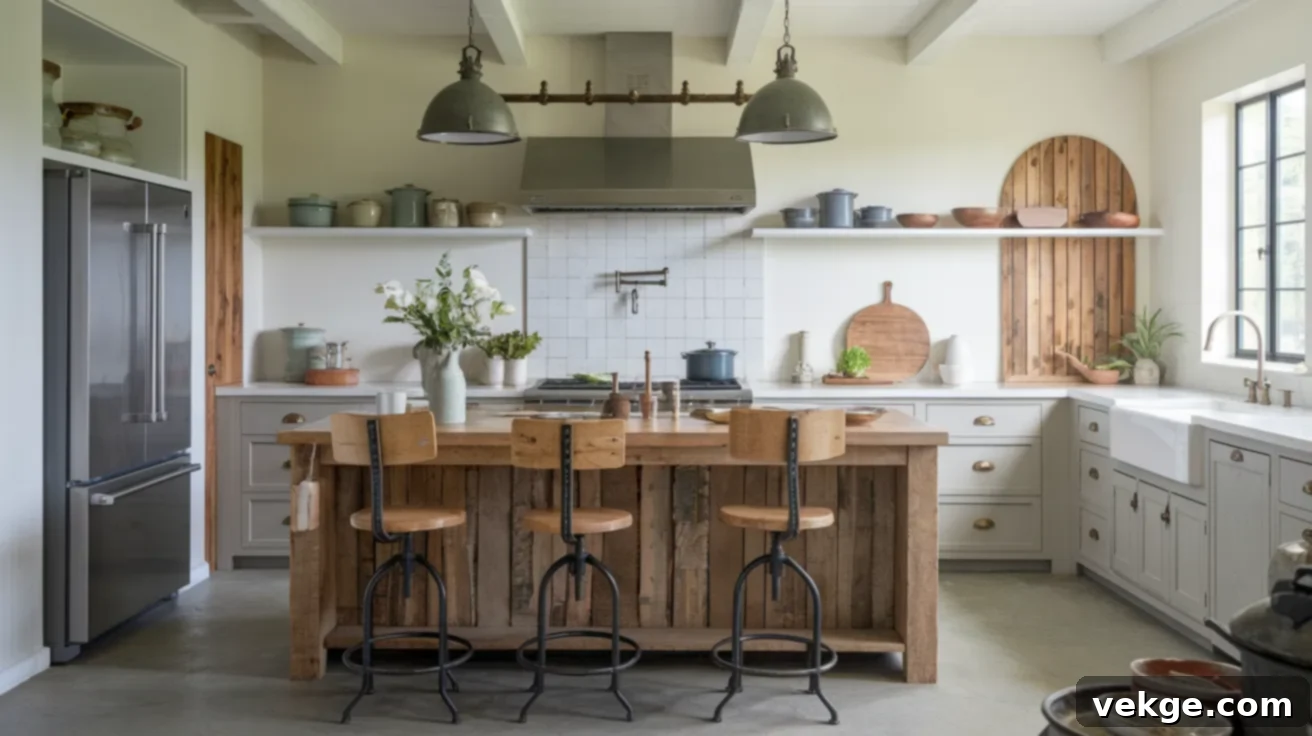
In the kitchen, merge functionality with style by combining mid-century modern appliances and hardware with rustic design elements. Opt for stainless steel appliances with clean, streamlined profiles, or consider retro-inspired appliances in muted colors that evoke the mid-century era. Contrast them with a robust farmhouse-style wooden kitchen island, perhaps with a butcher block top, or open shelving made from reclaimed wood or sturdy pipes.
Select bar stools that echo both design styles, such as those with metal frames and ergonomically shaped wooden seats. Use a neutral color palette for cabinets, favoring white, soft gray, or even a muted sage green, then add warmth through touches of copper cookware, wooden cutting boards, vintage ceramic containers, and an apron-front sink. A subway tile backsplash can provide a clean, timeless backdrop that works with both styles.
Bedroom

Create a serene retreat that balances modern sophistication with rustic comfort in your bedroom. Choose a platform bed with clean lines and minimal design, perhaps in a warm walnut finish or upholstered in a natural fabric. Layer it with soft, textured bedding in neutral tones like crisp whites, calming grays, or inviting earth tones. Add a vintage wooden dresser or a mid-century inspired credenza with sleek hardware, providing both storage and character.
Incorporate natural elements through woven wall hangings above the bed, a wooden bench at the foot of the bed, or bedside tables with simple, geometric forms. Use soft, ambient lighting with a mix of metal and wood elements, such as a sleek bedside lamp with a wooden base and a fabric shade, or a statement pendant light with a subtle industrial edge. The goal is a tranquil space that feels both current and deeply relaxing.
Bathroom and Hallways
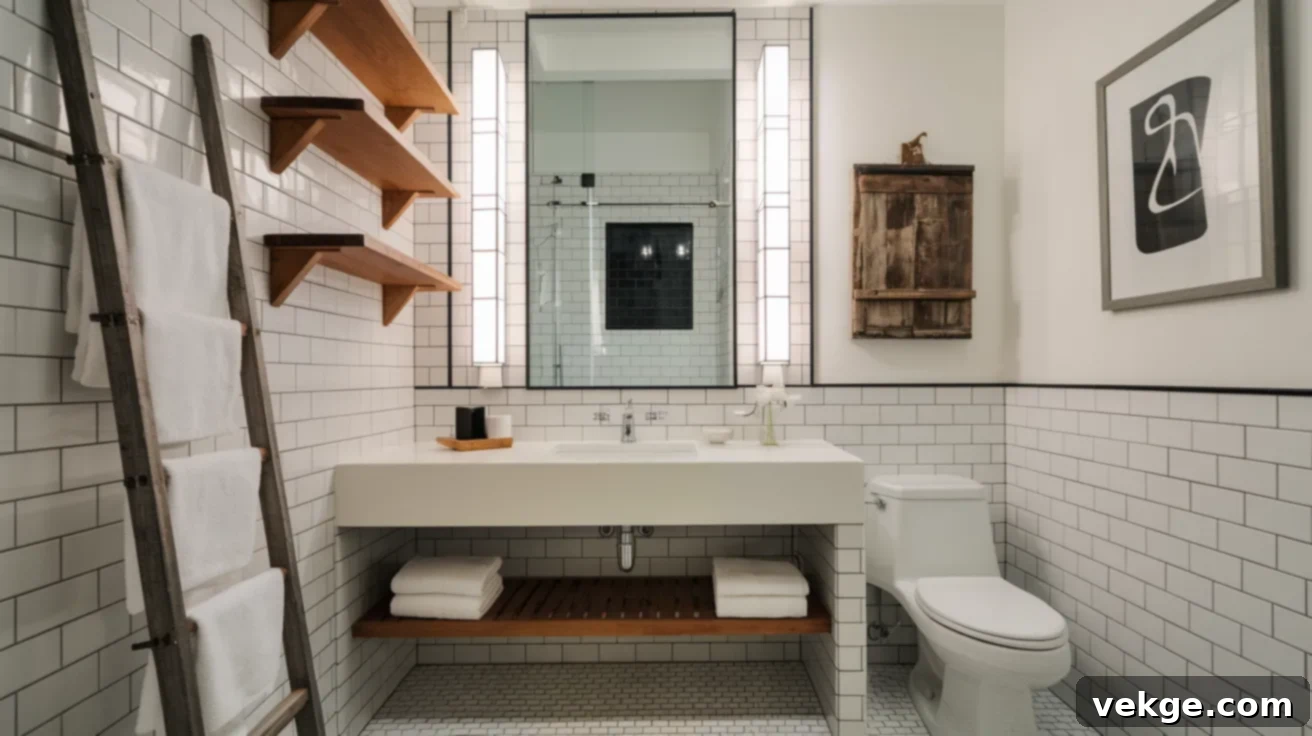
Design functional spaces like bathrooms and hallways to seamlessly mix both styles, ensuring a cohesive flow throughout your home. In the bathroom, select a minimalist floating vanity with clean lines and integrated storage, paired with a large framed mirror that features a wooden, metal, or even a subtle geometric frame. Use classic white subway tiles for a clean, timeless look on walls, then add warmth with wooden shelving for towels, a vintage ladder for storage, or a rustic stool. Opt for modern plumbing fixtures in matte black, brushed brass, or chrome.
In hallways, combine abstract artwork or geometric prints with rustic wooden picture frames, or lean a large vintage mirror against a wall. Choose lighting fixtures that feature simple geometric shapes with natural material accents, such as a ceiling flush mount with a wooden trim or sconces with a sleek metal arm and an exposed bulb. Use a consistent color palette of whites, grays, and warm wood tones to create a cohesive flow and connection throughout these often-overlooked connecting spaces.
Material and Color Choices for Mid-Century Modern Farmhouse
Selecting the right materials and colors is absolutely crucial to successfully combining mid-century modern and farmhouse design styles. The key lies in finding a balanced interplay that allows both styles to shine, creating a cohesive and visually appealing experience that feels harmonious.
Choosing the Right Wood and Metals
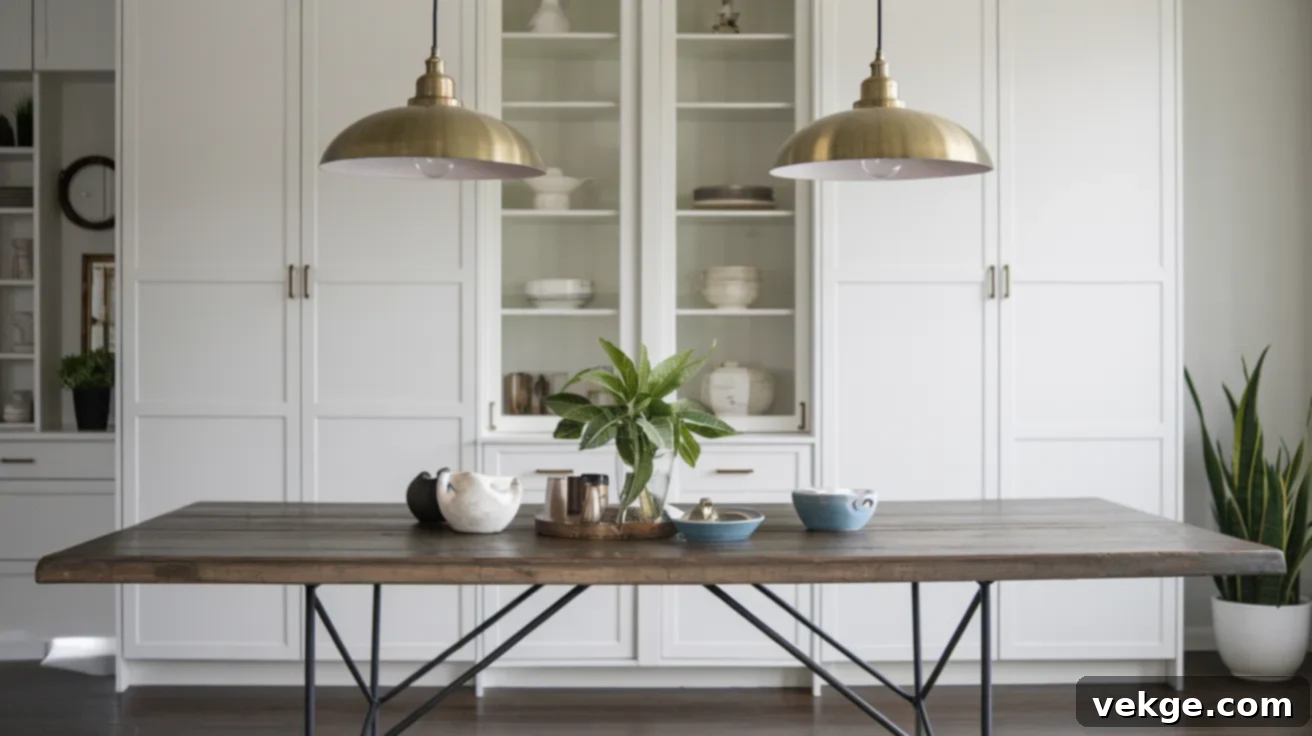
Wood plays a pivotal, unifying role in bridging mid-century modern and farmhouse styles. For mid-century elements, opt for warmer, lighter wood tones like walnut, teak, and white oak, often with smooth finishes and minimal visible grain, emphasizing their refined craftsmanship. Farmhouse styles, on the other hand, embrace more rustic, textured, and often distressed wood surfaces like reclaimed barnwood, pine, or oak with prominent grain patterns.
The trick is to combine them thoughtfully. Consider a sleek walnut credenza (mid-century) placed against a shiplap wall (farmhouse), or a dining table with a smooth, mid-century inspired top on sturdy, rustic wooden legs. For metals, combine the sleekness of brushed brass, polished chrome, or copper (mid-century) with the earthy, aged appeal of matte black, warm bronze, or wrought iron (farmhouse). Stainless steel works exceptionally well for mid-century appliances and hardware, while wrought iron adds farmhouse charm to light fixtures or decorative accents. Look for furniture and fixtures that expertly blend these metals – perhaps a pendant light that features both a metal shade and a wooden cap, or chairs with clean metal frames softened by wooden seats.
Color Palettes for a Unified Style
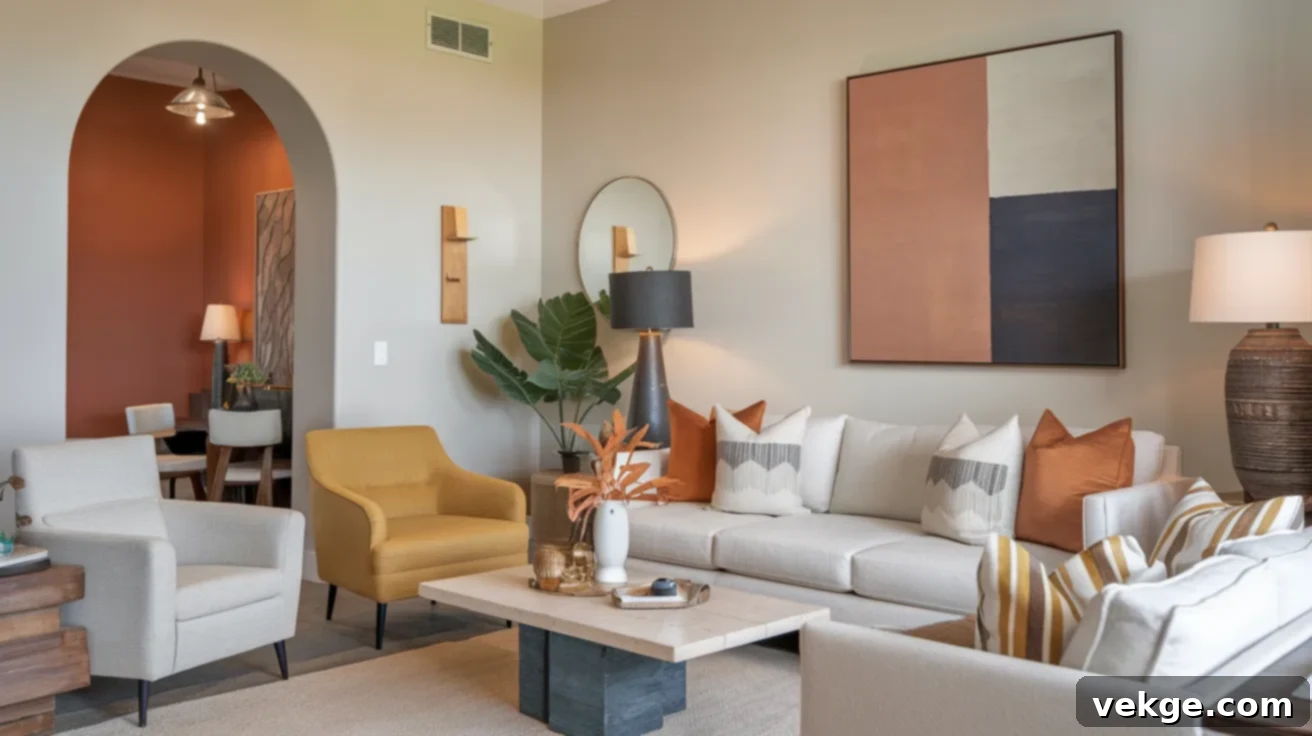
Creating a cohesive color scheme is paramount to honoring both design traditions without causing visual discord. Begin with a neutral base of crisp whites, soft grays, warm beiges, and muted creams. These foundational colors provide a versatile and calming backdrop that allows the unique elements of each style to stand out without clashing. For walls, consider off-white or a light greige to maintain an airy feel.
Introduce mid-century modern accent colors in thoughtful doses. Think of hues like mustard yellow, sage green, burnt orange, teal, or deep navy. These can appear in upholstery, throw pillows, abstract artwork, or small decorative objects. Complement these with farmhouse-inspired earth tones such as terracotta, muted blues (like dusty cornflower or slate), warm browns, and deep greens, which can be found in textiles, pottery, or vintage pieces. The goal is to maintain a balanced palette that feels both contemporary and classically inviting. Use lighter shades for larger surfaces like walls and major furniture pieces, then add depth and personality with richer, more saturated colors in smaller accessories, statement furniture pieces, or unique artworks. This approach allows the two styles to coexist harmoniously, creating a space that feels both refined and genuinely approachable.
Conclusion
Creating a home that truly resonates with your personal style means you don’t have to rigidly adhere to a single design rulebook. The beauty of the mid-century modern farmhouse aesthetic lies in its flexibility and ability to blend the best of both worlds. It’s all about what feels right for you and your unique living space.
Remarkable things happen when you strategically place clean, sophisticated shapes next to cozy, natural textures, and when you thoughtfully mix newer, minimalist pieces with cherished, older finds. Don’t be intimidated by the idea of achieving immediate perfection. Design is a journey, not a destination.
Start small: try incorporating one or two key items from each style, experiment with different color combinations, or test out various materials to see how the mix works within your existing decor. Your home should be a reflection of who you are—a place that effortlessly balances the sleek, elegant look of modern style with the comforting, heartfelt touches of more classic, homey farmhouse elements. It’s about building a space that is both aspirational and deeply comfortable.
Ready to embark on this exciting journey of blending styles? Look around your space, pick one corner or a single room, and let your creativity and design ideas come to life. The perfect blend awaits.
Frequently Asked Questions
What are the best types of wood to use for a mid-century modern farmhouse look?
Walnut, white oak, and teak are excellent choices as they offer warm tones and clean lines that perfectly bridge mid-century modern’s sleekness with farmhouse’s rustic charm. Reclaimed barnwood or distressed pine can also be incorporated for a strong farmhouse accent.
What are the essential furniture pieces for a mid-century modern farmhouse living room?
For a blended living room, invest in a low-profile sofa with tapered legs (perhaps in leather or natural linen), Eames-style accent chairs, a sturdy wooden coffee table (possibly reclaimed wood with a sleek base), and minimal open shelving or a mid-century credenza. Layer with natural fiber rugs and cozy throws.
What are some key lighting tips for blending mid-century modern and farmhouse styles?
Combine industrial-style pendant lights or matte black sconces for a farmhouse touch with sleek, warm-toned fixtures like brass Sputnik chandeliers or arc floor lamps for mid-century flair. Mix metal finishes thoughtfully and incorporate natural wood elements into your lighting choices for cohesion.
How can I incorporate mid-century modern farmhouse style into a small space?
In small spaces, prioritize multifunctional furniture with clean lines. Use a neutral color palette to make the room feel larger, and add texture through natural materials rather than clutter. Opt for wall-mounted shelving or credenzas to save floor space, and use mirrors to reflect light and expand the feel of the room.
